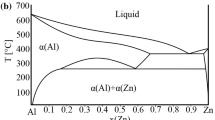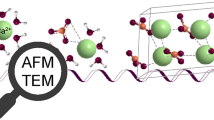Abstract
Equilibrium in the quaternary CaO–P2O5–H2CO3–H2O system at 298 K in air was studied in a region of low concentrations of liquid-phase components. We revealed a dependence of the composition of resultant equilibrium solid phases on the Ca/P ratio of the initial components and on pH of the equilibrium liquid phase. It was found that the entire region of the system having low concentrations of liquid-phase components is occupied by variable-composition compounds with apatite structure. Two types of carbonate-containing apatite compounds were detected. The first type of apatite forms at 5.4 ≤ pH ≤ 7.0, contains HPO42− groups in the lattice, and has an invariant point with brushite \({\text{CaHPO}}_{{4}} \cdot {\text{2H}}_{{2}} {\text{O}}\) at pH ≈ 5.4. The second type arises at pH > 7.0, does not contain an acidic group, and has an invariant point with CaCO3 at pH ≥ 8.







Similar content being viewed by others
References
Al-Hosney HA, Grassian VH (2005) Water, sulfur dioxide and nitric acid adsorption on calcium carbonate: a transmission and ATR-FTIR study. Phys Chem Chem Phys 7:1266–1276. https://doi.org/10.1039/B417872F
Ames LL (1959) The genesis of carbonate apatites. Econ Geol 54(5):829–841
Arends J, Davidson CL (1975) HPO42− Content in enamel and artificial carious lesions. Calcif Tissue Res 18(1):65–79
Bakher Z, Kaddami M (2018a) Thermodynamic equilibrium in the system H2O–P2O5-CaCO3 at 25 and 70°C: Application for synthesis of calcium phosphate products based on calcium carbonate decomposition. Fluid Phase Equilib 456:46–56. https://doi.org/10.1016/j.fluid.2017.10.005
Bakher Z, Kaddami M (2018b) Solubility study at high phosphorus pentoxide concentration in ternary system CaCO3-P2O5-H2O at 25, 35 and 70 C. Fluid Phase Equilib 478:90–99. https://doi.org/10.1016/j.fluid.2018.09.006
Baturin GN (1982) Phosphorites on the sea floor origin composition and distribution. Elsevier scientific publishing company, Amsterdam-Oxford-New York, p 355
Baturin GN, Bezrukov PL (1979) Phosphorites on the sea floor and their origin. Mar Geol 31:317–332
Bonel G, Labarthe JC, Vignoles C (1975) Contribution a l’etude structurale des apatites carbonatées de type B. In: Physico-Chimie et Cristallographie des Apatites d’interet Biologiques Paris, CNRS, pp 117–125.
Chaikina MV, Bulina NV (2022) Formation of calcium phosphate apatite in system CaO-P2O5-H2O: equilibrium at 298 K under a nitrogen atmosphere. Current Appl Mater. https://doi.org/10.2174/2666731201666221006102124
Combes C, Cazalbou S, Rey C (2016) Apatite Biominerals. Minerals 6(2):34. https://doi.org/10.3390/min6020034
Elliott JC (1994) Structure and chemistry of the apatites and other calcium orthophosphates. Elsevier, Amsterdam
Elliott JC, Bonel G, Trombe JC (1980) Space group and lattice constants of Ca10(PO4)6CO3. J Appl Cryst 13:618–621
Farr TD, Tarbutton G, Lewis HT (1962) System CaO-P2O5-HF-H2O: equilibrium at 25 and 50°. J Phys Chem 66(2):318–321
Fox JL, Wang Z, Hsu J, Baig A, Colby S, Powell GL, Otsuka M, Higuchi WI (1995) Metastable equilibrium solubility distribution and dissolution kinetics of carbonate apatite powders. In: Amjad Z (ed) Mineral Scale Formation and Inhibition. Plenum Press, New York, pp 231–250
Le Geros RZ, Trautz OR, Le Geros JP (1968) Carbonate substitution in the apatite structure. In: Bulletin de la Societe chimique de France, pp.1712–1717
Harris DC (2003) Quantitative chemical analysis, 6th edn. W.H. Freeman and Company, New York, pp 259–277
Hayek E, Link H (1975) Hydrogen phosphate and carbonate in synthetic calcium phosphate and in the bone mineral. In: Colloques Internationaux du Centre National de la Recherche Scientifique. CNRS, Paris, pp101–104
Hsu J, Fox JL, Higuchi WI, Powell GL, Baig A, LeGeros RZ (1994) Metastable equilibrium solubility behavior of carbonated apatites. J Colloid Interface Sci 167:414–423. https://doi.org/10.1006/jcis.1994.1376
Interstate Standard GOST 34467–2018 (2019b). Grunts. Methods of laboratory determination of carbonate content. Official publication. Moscow: Standartinform
Interstate Standard GOST 31954–2012 (2014) Drinking water. Methods for determining hardness. Moscow: Standartinform
Interstate Standard GOST 18309–2014 (2015a) Water. Methods for determination of phosphorus-containing matters. Moscow: Standartinform
Interstate Standard GOST 24 596.2–2015b (2015b) Feed phosphates. Methods for determination of phosphates. Moscow: Standartinform
Interstate Standard GOST 31957–2012 (2019a) Water. Methods for determining alkalinity and mass concentration of carbonates and hydrocarbonates. Moscow: Standartinform
ISO 9963–1 (1994) Water quality–Determination of alkalinity–Part 1: Determination of total and composite alkalinity
Kelly LE, Farr TD (1940) Equilibrium in the system calcium oxide-phosphorus-pentoxide-water. Ind Eng Chem 32(4):580–586. https://doi.org/10.1021/ie50364a030
Kühl G, Nebergall WH (1963) Hydrogenphosphat und carbonatapatite. Z Anorg Allg Chem 324:313–320. https://doi.org/10.1002/zaac.19633240513
Kunin AA, Belenova IA, Ippolitov YA, Moiseeva NS, Kunin DA (2013) Predictive research methods of enamel and dentine for initial caries detection. EPMA J 4:1–10
Labarthe JC, Bonel G, Montel G (1973) Structure and properties of B-type phosphocalcium carbonate apatites. Ann Chim 8:289–301
LeGeros RZ (2001) Formation and transformation of calcium phosphates: relevance to vascular calcification. Z Kardiol 90:116–124. https://doi.org/10.1007/s003920170032
Liu Q, Huang S, Matinlinna JP, Chen Z, Pan H (2013) Insight into biological apatite: physiochemical properties and preparation approaches. BioMed Res Int. https://doi.org/10.1155/2013/929748
Moreno EC, Gregory TM, Brown WE (1968) Preparation and solubility of hydroxyapatite. J Res Natl Bur Stand A Phys Chem 72A(6):773–782
Omelon S, Ariganello M, Bonucci E, Grynpas M, Nanci A (2013) A review of phosphate mineral nucleation in biology and geobiology. Calcif Tissue Int 93:382–396. https://doi.org/10.1007/s00223-013-9784-9
Pasteris JD (2012) Structurally incorporated water in bone apatite: a cautionary tale. In: Heimann RB (ed) Calcium phosphate. Nova Science Publishers, New York
Ptáček P (2016a) Phosphate rocks. In: Ptáček P (ed) Apatites and their synthetic analogues–synthesis, structure, properties and applications. InTech, Croatia, pp 335–382
Ptáček P (2016b) Utilization of Apatite Ores. In: Ptáček P (ed) Apatites and their synthetic analogues–synthesis, structure, properties and applications. InTech, Croatia, pp 417–454
Rey C, Collins B, Goehl T, Dickson IR, Glimcher MJ (1989) The carbonate environment in bone mineral: a resolution-enhanced fourier transform infrared spectroscopy study. Calcif Tissue Int 45:157–164
Rey C, Renugopalakrishnan V, Collins B, Glimcher MJ (1991) Fourier transform infrared spectroscopic study of the carbonate ions in bone mineral during aging. Calcif Tissue Int 49:251–258. https://doi.org/10.1007/BF02556214
Rey C, Combes C, Drouet C, Sfihi H, Barroug A (2007) Physico-chemical properties of nanocrystalline apatites: implications for biominerals and biomaterials. Mater Sci Eng C 27:198–205. https://doi.org/10.1016/j.msec.2006.05.015
Smith SM, Abrams SA, David-Street JE, Heer M, O’Brien KO, Wastney ME, Zwart SR (2014) Fifty years of human space travel: Implications for bone and calcium research. Annu Rev Nutr 34:377–400. https://doi.org/10.1155/2013/929748
Standard ISO 6878 (2004) Water quality–Determination of phosphorus–ammonium molybdate spectrometric method
Vagenas NV, Gatsouli A, Kontoyannis CG (2003) Quantitative analysis of synthetic calcium carbonate polymorphs using FT-IR spectroscopy. Talanta 59:831–836. https://doi.org/10.1016/S0039-9140(02)00638-0
Vallet-Regi M, Arcos DN (2015) Biological apatites in bone and teeth. Nanoceramics in clinical use from materials to applications, 2nd edn. Royal Society of Chemistry publishing, London, pp 1–29
Van Wazer JR (1961) Phosphorus and its compounds vol. 2, technology, biological functions and applications. Interscience, New York
Vignoles M, Bonel G, Holcomb DW, Young RA (1988) Influence of preparation conditions on the composition of type B carbonated. Calcif Tissue Int 43:33–40
Wilson R, Elliott JC, Dowker SEP (2005) Rietveld refinements and spectroscopic studies of the structure of Ca-deficient apatite. Biomaterials 26:1317–1327. https://doi.org/10.1016/j.biomaterials.2004.04.038
Acknowledgements
This research was carried out within a state assignment to the Institute of Solid State Chemistry and Mechanochemistry SB RAS (Project No. 121032500064-8).
Author information
Authors and Affiliations
Corresponding author
Ethics declarations
Conflict of interest
The authors declare that there is no conflict of interest.
Additional information
Publisher's Note
Springer Nature remains neutral with regard to jurisdictional claims in published maps and institutional affiliations.
Supplementary Information
Below is the link to the electronic supplementary material.
Rights and permissions
Springer Nature or its licensor (e.g. a society or other partner) holds exclusive rights to this article under a publishing agreement with the author(s) or other rightsholder(s); author self-archiving of the accepted manuscript version of this article is solely governed by the terms of such publishing agreement and applicable law.
About this article
Cite this article
Chaikina, M.V., Bulina, N.V., Prosanov, I.Y. et al. Formation of carbonated apatite in equilibrium system CaO–P2O5–H2CO3–H2O at 298 K in air. Chem. Pap. 77, 5763–5771 (2023). https://doi.org/10.1007/s11696-023-02895-0
Received:
Accepted:
Published:
Issue Date:
DOI: https://doi.org/10.1007/s11696-023-02895-0




